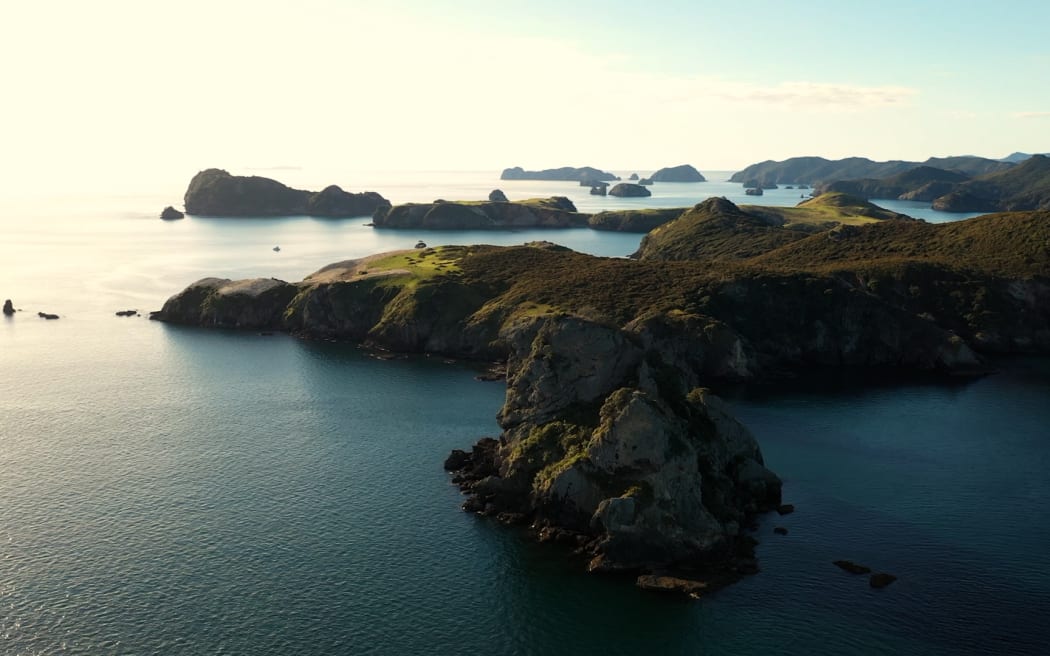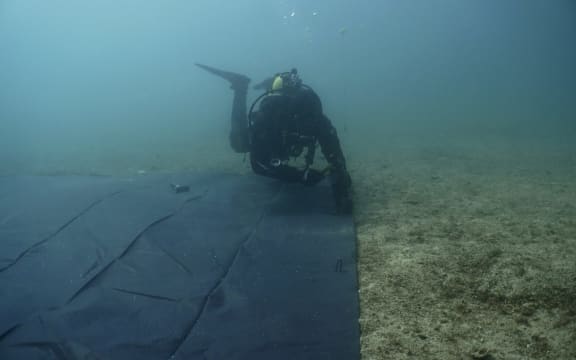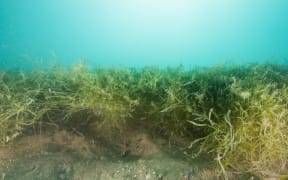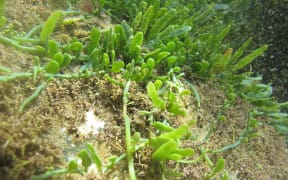
Aotea Great Barrier. Photo:
Two public meetings this week will help set a path forward for New Zealand's sixth-biggest island as it grapples with an invasion by one of the world's worst seaweed pests.
Anchoring boats is already banned in three harbours at Aotea Great Barrier, 100km northeast of Auckland, in an effort to stop the spread of exotic caulerpa.
But with the seaweed continuing to spread and the restrictions - known as Controlled Area Notices, or CANs - due to expire at the end of the month, islanders and biosecurity officials have little time to decide their next steps.
Some residents want the island closed entirely to visiting boaties while others say the battle is already lost and restrictions are pointless.
A more likely path, depending on the outcome of this week's hui, is to renew and possibly expand the CANs currently in force at Okupu Bay, Tryphena Harbour and Whangaparapara Harbour.
It is believed the green menace is primarily spread by anchors. In suitable conditions a piece of seaweed the size of a pinhead can grow to the size of a football field in just three weeks.
Aotea Great Barrier Environmental Trust deputy chairperson Dr Barry Scott said caulerpa quickly covered everything in its path.
"It just grows like a mat across the seabed and smothers everything. It smothers the native seaweeds, it changes the invertebrates in the sediment underneath, and basically makes it quite inhospitable for fish, both shellfish and swimming fish. We already know from studies of the Mediterranean that it has a huge impact on fisheries and biodiversity."
Scott, also an emeritus professor at Massey University, said since the CANs were put in place caulerpa had also been found at the Broken Islands and at the entrance to Port Fitzroy. Both were popular with boaties, especially now the island's other sheltered anchorages were closed.

Caulerpa. Photo: Sid Wales / Ministry for Primary Industries
"The problem is there hasn't been really extensive surveillance so we don't in fact know where caulerpa is and where it isn't. Our trust is paying for some surveillance using underwater drones to start this week because we have this gap in knowledge.
"It's kind of frustrating because it's almost the end of November, the CAN time period is almost up, and we don't have this crucial information."
Scott said it seemed "extraordinary" that two-and-a-half years into the outbreak, Biosecurity NZ still was not using underwater drones for initial surveillance at Aotea. Instead the agency used divers, who could only cover limited areas.

Divers investigating caulerpa in Northland earlier this year. Photo: Supplied/ Brett Sutton, Marine Environmental Field Services
He hoped the CANs would be extended both in area and duration. Unlike recent land-based biosecurity threats such as kauri dieback and myrtle rust, he believed there was still a chance of controlling caulerpa.
"But we're really getting into that difficult zone now. This thing could spread right from North Cape down to Tauranga, which is an enormous area of harbours and bays along the east coast of the North Island, with a huge impact for kai moana, for biodiversity, for recreation and for commercial fishing."
Scott said the Bay of Islands was going "hard out" for eradication, but that would be in vain if boats were able to spread it from the Barrier back to the Far North.
Listening to locals
Biosecurity and MPI staff would attend two hui on Aotea this week to gauge islanders' views on dealing with caulerpa. The first will hear from iwi while the second, from 6pm on Thursday at Claris Sports Club, is open to the wider community.
Chris Ollivier, an Aotea Great Barrier Local Board member and charter boat operator, said views on the island ranged from shutting out boats entirely to giving up the fight.
He said the main feeling was frustration that the CANs had failed to stop the spread of caulerpa, though it was likely the seaweed had spread before the restrictions were put in place.
It was even possible the seaweed had originally taken hold in the Bay of Islands, even though it was first discovered at Aotea's Okupu Bay.
"There's a strong push from mana whenua in the north of the island who want to protect that area and close it off before caulerpa gets there. We also have a smaller minority saying, 'It's all too late, forget it, just go away and let us get on with our lives.'"
Ollivier said there was "reasonably strong" backing for the current restrictions, and it seemed likely the CANs would be expanded. That would, however, make the restrictions much more onerous.
"At the moment the restrictions for most people are quite manageable because they can fish outside those areas. But if you start closing off the Broken Islands and Port Fitzroy you're going to have a much more significant effect on visiting boaties and opportunities to anchor and fish."
One option to reduce the impact would be to allow drift fishing in those areas, which had a much lower risk of spreading the pest seaweed.
Any restrictions in Port Fitzroy would also have a major effect on the local store, where visiting boaties bought many of their provisions.
"But the big risk is the loss of kai moana on the island. We're looking at the complete loss of scallops really, and a significant risk to crayfish and other bottom-dwelling species. Anything you'd normally harvest from the bottom is at risk because of the smothering effect."
Local board chairwoman Izzy Fordham urged islanders to attend Thursday's hui to have their say and give MPI direction as it considered its next steps.
"It's crucial that we hear from our people. This is something that's vitally important to our island, our moana, and our kai moana."
While islanders felt frustrated after two years of living with CANs they also understood the severity of the problem, she said.
CANs, along with rāhui set by local hapū, are also in force at caulerpa sites at Great Mercury Island and Te Rāwhiti Inlet in the Bay of Islands. Caulerpa has also been found at Waiheke Island and near Kawau island.
At Te Rāwhiti, a response led by the Northland Regional Council is attempting to use suction dredging to eradicate the pest.




